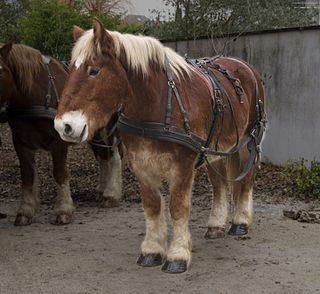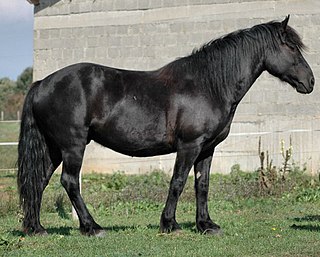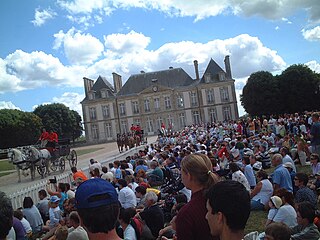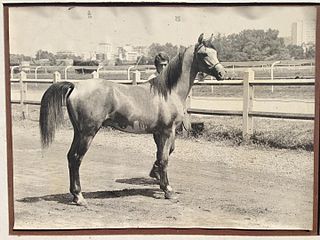
The Percheron is a breed of draft horse that originated in the Huisne river valley in western France, part of the former Perche province, from which the breed takes its name. Usually gray or black in color, Percherons are well-muscled, and known for their intelligence and willingness to work. Although their exact origins are unknown, the ancestors of the breed were present in the valley by the 17th century. They are believed to descend from war horses. Over time, they began to be used for pulling stagecoaches; and later, for agriculture and hauling heavy goods. In the late 18th and early 19th centuries, Arabian blood was added to the breed. Exports of Percherons from France rose exponentially in the late 19th century, and the first purely Percheron stud book was created in France in 1893.

The Boulonnais, also known as the "White Marble Horse", is a draft horse breed. It is known for its large but elegant appearance and is usually gray, although chestnut and black are also allowed by the French breed registry. Originally there were several sub-types, but they were crossbred until only one is seen today. The breed's origins trace to a period before the Crusades and, during the 17th century, Spanish Barb, Arabian, and Andalusian blood were added to create the modern type.

The Trait Breton is a French breed of draught horse. It originated in Brittany, in north-west France, from cross-breeding of local horses with various other breeds. It is strong and muscular, and often has a chestnut coat.

The Auxois is a horse breed from eastern France. It is a large breed, with some individuals weighing over 910 kilograms (2,010 lb), bred for horse meat, agricultural work and leisure pursuits. Overall, members of the breed are solid and muscular in appearance. They are usually bay or bay roan in color, although some other colors are accepted by the breed registry, and are known for their power and docility.

The Trait du Nord, previously also known as Ardennais du Nord or Ardennais de type Nord, is a breed of heavy draft horse developed and bred in the area of Hainaut in western Belgium and in northeastern France. Originally considered a subtype of the Ardennes, it was recognized as an individual breed with the opening of a studbook in 1903. Developed in the fertile Flemish grasslands, it was bred for size and pulling power for agricultural work. By 1855, the horses bred near Hainaut were considered by some veterinarians to be superior to other Flemish draft breeds. The Trait du Nord was used extensively in mining from the late 19th century through 1920, with lesser use continuing through the 1960s.

The Mérens, Cheval de Mérens or Caballo de Merens, still occasionally referred to by the older name of Ariégeois pony, is a small, rustic horse native to the Pyrenees and Ariégeois mountains of southern France, where the river Ariège flows, and northern Spain, near Andorra. Two general types, a small, light traditional mountain horse and a taller, sportier modern type, are found. Always black in color, Mérens must meet strict physical standards in order to be registered in the stud book. The breed is known for its sure-footedness on mountain terrain, as well as for its endurance, hardiness and docility. The French breed registry organizes regional offices, and partners with other national organizations in Europe to preserve and promote the breed. The organization enforces rigorous selection of breeding stock, with a goal of increasing quality in the breed. In the past, the Mérens was used for farm work, draft work and as pack horses. Today it is mainly used as a saddle horse, although some members of the breed have been successful in carriage driving. Many Mérens are taken on an annual transhumance, in which they are moved higher in the mountains during the summer and into the valleys for the winter. An old practice, it fell into disfavor, but has recently re-emerged.

The Poitevin or Poitou is a French breed of draft horse. It is named for its area of origin, the former province of Poitou in west-central France, now a part of the region of Nouvelle-Aquitaine. It was formed in the seventeenth century when horses of Flemish or Dutch origin, brought to the area by engineers working to drain the Marais Poitevin, interbred with local horses. Although it has the size and conformation of a draft horse, the Poitevin has never been bred for draft abilities, and has been little used for draft work. Its principal traditional use was the production of mules. Poitevin mares were put to jacks of the large Baudet du Poitou breed of donkey; the resulting Poitevin mules were in demand for agricultural and other work in many parts of the world, including Russia and the United States. In the early twentieth century there were some 50,000 brood mares producing between 18,000 and 20,000 mules per year.

The Anglo-Norman horse is a warmblood horse breed developed in Lower Normandy in northern France. A major center of horse breeding, the area had numerous regional types that were bred to one another and then crossed with Thoroughbreds to form the Anglo-Norman. Various body types developed within the Anglo-Norman breed, two of which were split off to form the Norman Cob and French Trotter. The remaining types were eventually standardized, although there remained some criticism of the "hybrid" nature of the breed's conformation. However, it is successful as an international sport horse, especially in the sport of show jumping. The Anglo-Norman also contributed to the development of several other breeds in Europe and Asia.

The French Trotter is a French breed of trotting horse bred for racing both ridden and in harness. It was bred specifically for racing in the 19th century (1800s), principally in Normandy in north-western France.

The Norman Cob or Cob Normand is a breed of light draught horse that originated in the region of Normandy in northern France. It is of medium size, with a range of heights and weights, due to selective breeding for a wide range of uses. Its conformation is similar to a robust Thoroughbred, and it more closely resembles a Thoroughbred cross than other French draught breeds. The breed is known for its lively, long-striding trot. Common colours include chestnut, bay and seal brown. There are three general subsets within the breed: horses used under saddle, those used in harness, and those destined for meat production. It is popular for recreational and competitive driving, representing France internationally in the latter, and is also used for several riding disciplines.

The Henson Horse, or Cheval de Henson, is a modern horse breed from northeast France. It was created by the selective breeding of light saddle horses with the smaller, heavier Norwegian Fjord horse to create small horses suitable for the equestrian vacation industry. The breeders' association, Association du Cheval Henson, was formed in 1983. In 1995 the studbook was closed to horses not born from Henson parents, and in 2003 the breed was officially recognised by the French government agencies for horse breeding. A hardy breed of horse, each winter the broodmares and youngstock from several breeders are let loose together to graze freely in the wetland reserves in France.

The Haras Nationaux in France was the French national public administrative body responsible for the regulation and administration of breeding of horses and donkeys in France. It administered twenty-two regional studs, or horse-breeding centres.
The National Stud Farm of Chaouchaoua is a stud in Tiaret in Algeria. The institution is dedicated to the preservation and improvement of Algerian horse breeds, founded in 1874. It is now a center of expertise for issues related to breeding and care of equines.

Horses in Normandy have a clear economic importance, particularly through breeding. Present since the Bronze Age, horse breeding developed with the establishment of the Haras du Pin stud farm. Horses are still a very much alive tradition in this region. Normandy boasts a number of renowned racecourses, in particular the one in Deauville, where events take place regularly, including international ones such as the 2014 World Equestrian Games.

Narquois was a racehorse born in Calvados, an Anglo-Norman trotter. He was one of the first sons of the main stallion behind the French Trotter, the head of the Fuschia breed. Like him, Narquois became an excellent competitor, but at the same time was renowned for his ugliness. He usually competed in pairs with his half-sister, the mare Nitouche.

Persik, born on 1 April 1969 and died on 24 August 2001, was a gray-coated Arabian horse who was the leading sire in the equestrian discipline of endurance from 1975 until his death in 2001. His eclectic origins include Polish and Russian bloodlines, as well as French and English, in particular the famous Skowronek. Purchased in 1973 from the Tersk stud farm, Persik was imported to France by Jean Cougul, a breeder from Vigoulet-Auzil, then bought by the Cévennes National Park with the aim of breeding horses suitable for trail riding. In 1975, Persik won the first edition of a well-known endurance race, the 130 km de Florac.

The Arabo-friesian is a recent breed of horse, selected over several generations since the 1960s to obtain the morphology of the modern Friesian combined with the endurance qualities of the Arabian. The creation of this breed was strongly contested by some Dutch Friesian breeders, who went so far as to set fire to the stables where the first crosses were made.

The Norfolk Phœnomenon is a black-coated stallion of the Norfolk Trotter breed. He is a son or grandson of the most famous English trotter stallion of his time, The Norfolk Phenomenon. He was imported to France in 1851 on a mission from the Haras Nationaux.

Conquérant was a founding stallion of the French Trotter horse breed, born in 1858 in Cotentin, Normandy, to breeder Pierre Étienne Joseph-Lafosse, and died in 1880. Son of the mare Élisa and the stallion Kapirat, descended through him from the almost Thoroughbred Young Rattler, he had an excellent racing career in mounted trotting for the Basly stable. Sold to the Haras Nationaux in 1862 after his racing career, Conquérant became a sought-after sire of 66 trotters.

The Haras National de Lamballe is one of five equestrian centers in the French region of Brittany. Originally, it was a depot for royal stallions, created in the autumn of 1783 in the sole stable of a barracks in the town of Lamballe. Abolished in 1790, briefly recreated in 1825, this national stud took on its definitive form in 1842, when it was given the task of making breeding stallions available to the owners of the 70,000 broodmares in its district. Numerous extensions led to the construction of eleven new stables until the beginning of the 20th century, housing up to 350 stallions of all breeds. The National Stud played a major role in the development of the Norfolk-Breton breed, the future Breton horse, by importing Norfolk Trotter stallions from England. It was also responsible for the success of the half-Ardennes stallion Naous, one of the founding stallions of the Breton horse breed.



















